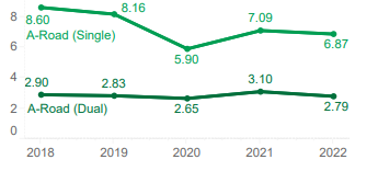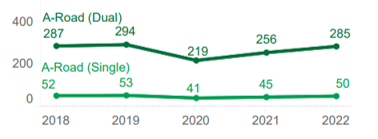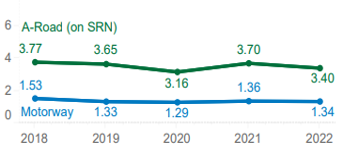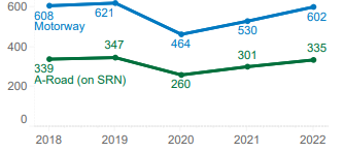Innovation and Research Designated Fund - 2025 open call challenges
These five challenges will shape our next programme but do not reflect all priorities across National Highways. The challenge pipeline will remain agile, evolving to support different priorities and long-term ambitions through future open calls.
How to submit a project idea
Project idea submissions open on 3 November 2025.
Use this form to submit your proposal.
Where to find guidance
Please refer to the Challenge-led approach page and the challenge information below to inform your submission.
We've hosted a webinar discussing the Open Call 2025 challenges - watch a recording of the Open call webinar here.
About the challenges
The challenges are centred on customer experience; road safety; and health, safety and wellbeing.
- Improve customer experience of journey time (customer experience)
- Increase safety on A-roads (road safety)
- Maximise safety benefits while improving resilience of our network assets (road safety)
- Reduce live traffic interface risks (health, safety and wellbeing)
- Reduce occupational health risks (health, safety and wellbeing)
Challenge details
Explore the five challenges and their details below or download the full overview (PDF).
How can we improve customer experience of journey time?
Customer perceptions and expectations of journey time and traffic volumes are key drivers of satisfaction in the Strategic Roads User Survey (SRUS), which underpins our user satisfaction KPI for RP3. This is closely aligned with our average delay and journey time reliability KPI, both of which have declined in recent years.
We know perceptions of journey time do not always reflect actual measured delay at specific locations, although rising average delay has coincided with falling SRUS satisfaction.
Solutions should positively influence customer perceptions of journey time, maintain safety, support environmental sustainability, be scalable, and offer value for money.
We are seeking solutions that could address one or more of the following:
- Improve how we explain and communicate delay, roadworks, and expected journey time.
- Improve management of recurrent delays and reduce hotspots.
- Reduce incident duration and associated delays.
- Minimise the impact of roadworks by optimising network occupancy.
- Enhance journey experience through better use of customer-centric data
Average delay per vehicle per second per mile split by reason for 2023-24
Average delay = 10.67 seconds
| Recurrent (7.43 seconds) | Non-recurrent (3.24 seconds) |
|---|---|
| Roadworks - 0.52 seconds | Incident - 0.26 seconds |
| HGV - 1.05 seconds | Incident delay - 0.52 seconds |
| Winter darkness - 0.26 seconds | Weather - 0.79 seconds |
| Congestion - 3.91 seconds | Roadworks - 0.61 seconds |
| Geometry - 1.69 seconds | Other - 1.06 seconds |
Analysis of the SRUS indicates a negative correlation between average delay and customer satisfaction
Expected benefits
- Customer: Improved customer satisfaction.
- Operational: Reduced delays and more effective use of resources.
- Social: Journey time savings and broader economic benefits.
- Reputation: Strengthened public trust and operational reputation.
How can we increase safety on A-roads?
We want everyone who uses or works on our roads to get home safe and well. While England’s motorways and major A-roads are among the safest in the world, A-roads, especially single carriageways, continue to see disproportionately high numbers of people killed or seriously injured (KSIs) per hundred million vehicle miles (hmvm).
Single carriageway A-roads present challenges, with characteristics that can increase exposure to risk. Dual carriageway A-roads carry more traffic and, although they have a lower KSI rate per vehicle mile, their high usage contributes to a greater total number of KSIs.
We’re looking for innovative, practical solutions that help us better understand and reduce harm across the A-road network. These solutions should improve safety outcomes, support environmental sustainability, be scalable, and offer value for money.
We are seeking solutions that could address one or more of the following:
- Reduce the frequency and severity of shunt collisions
- Reduce the likelihood and/or severity of KSIs
- Improve safety on both single and dual carriageway A-roads
Our network
| Type of road | Length (miles) |
|---|---|
| Motorway | 1,913 |
| A-road duel | 1,789 |
| A-road single | 846 |
Expected benefits
- Safety: Reduced risk of fatality and serious injury.
- Operational: Smoother journeys with fewer disruptions.
- Reputation: Safer journeys builds public confidence.

KSIs per hmvm on A-roads dual and single: 2018-2022

Traffic in hmvm on A-roads dual and single: 2018-2022

KSIs per hmvm on Motorways and A-Roads: 2018-2022

Traffic in hmvm on Motorways and A-Roads: 2018-2022
How can we maximise safety benefits while improving resilience of our network assets?
We are committed to building and maintaining a network that is safe, reliable and resilient, one that performs over time and protects those who use and work on it. As the strategic road network continues to age and face changing conditions, we must manage increasing pressures on asset performance, safety and long-term sustainability. This includes improving understanding of asset resilience (including the association with safety and sustainability outcomes) over time to inform decisions on maintenance, renewals and investment.
We’re looking for innovative, practical solutions that support the development of a safer, more sustainable and longer-lasting network. These solutions should improve safety outcomes, support environmental sustainability, be scalable and offer value for money.
We are seeking solutions that could address one or more of the following:
- Improve asset resilience to reduce renewals and enhance safety for road users and workers (KPI1, PI1.4)
- Improve asset data to support whole-life cost and renewal planning
- Improve asset accessibility or reduce the need for in-person inspection
- Improve understanding of how renewal investment decisions impact safety outcomes, and environmental sustainability
How resilience of network assets relates to a zero-harm network
Poor safety performance can lead to increased maintenance needs and early asset renewal. This places pressure on maintenance and renewal budgets. Financial strain can reduce appetite and funding for new safety infrastructure, particularly where sustainability performance is poor.
Routine maintenance and renewals are often assumed to contribute to safety. However, replacing like-for-like assets does not improve resilience or safety outcomes over time. In relation to KPI1, maintenance and renewals may have varying impacts on the KSI rate per hundred million vehicle miles (hmvm):
- A lower KSI rate may be observed where safer assets are introduced, or asset degradation is reduced.
- The KSI rate may remain stable where assets are replaced like-for-like.
- A higher KSI rate may occur where maintenance and renewal activity is insufficient.
Only the first scenario supports a reduction in the number of KSIs on the SRN, helping to counter the historical trend of increasing traffic volumes.
Maintenance and renewal activities also affect road worker safety, as working on the network introduces exposure to risk. This links directly to PI1.4.
Together, improved data, asset resilience, and environmental sustainability could support improved safety outcomes for both road users and workers, as measured by KPI1 and PI1.4.
KPI1 – safety for road users
Measures the number of people killed or seriously injured (KSI) on the SRN.
PI1.4 – safety for road workers
Tracks the accident frequency rate (AFR) for National Highways staff and supply chain.
Expected benefits
- Safety: Reduced risk of injury or fatality.
- Operational: Smoother journeys with fewer disruptions.
- Financial: Reduced need for future interventions and maintenance.
- Reputation: Safer journeys builds public confidence.
How can we reduce live traffic interface risks?
Working in close proximity to live lane traffic presents one of the highest risks on the Strategic Road Network. Despite improvements, incident rates remain high, with 3,617 incidents reported in 2024. National Highways is committed to eliminating live lane working and reducing exposure wherever possible, but live traffic interfaces still occur and pose serious safety challenges.
We’re looking for innovative, practical solutions that help us better understand and reduce live traffic interface risks. These solutions should improve safety outcomes, support environmental sustainability, be scalable, and offer value for money.
We are seeking solutions that could address one or more of the following:
- Eliminate the need for people to work in live traffic environments.
- Minimise the duration and frequency of exposure to live traffic.
- Strengthen safe working practices in high-risk environments.
- Enhance safer behaviours among road workers and road users.
| Year | Traffic management related events |
|---|---|
| 2021 | 4,884 |
| 2022 | 3,782 |
| 2023 | 3,250 |
| 2024 | 3,617 |
| Total | 15,533 |
Expected benefits
- Safety: Reduced risk of injury or fatality.
- Operational: Minimised disruptions and delays in traffic flow.
- Financial: Lowers costs through fewer accidents and improved efficiency.
- Reputation: Safer journeys builds public confidence.
How can we reduce occupational health risks?
Occupational health risks account for 99% of work-related fatalities and 88% of working days lost, costing the UK over £21.6 billion each year. In highways, which makes up a third of construction activity, tens of thousands of workers suffer long-term ill-health, most commonly musculoskeletal disorders, respiratory disease and cancer.
Unlike accidents, health risks develop gradually and are often overlooked, yet their long-term impact is far greater. The sector has historically focused on safety, but health must now be given equal priority.
We’re looking for innovative, practical solutions that help us better understand and reduce occupational health risks. These solutions should improve health outcomes, be scalable and offer value for money.
We are seeking solutions that could address one or more of the following:
- Reduce incidence of long-term ill-health.
- Reduce working days lost to occupational conditions.
- Improve identification and control of key highway health risks.
- Increase adoption of preventative occupational hygiene practices.
- Embed health risk elimination and substitution in design and planning.
Occupational hygiene reduces health risks
Highways generally has adequate occupational health provision to manage the health of workers as it is today, and we are driving wellbeing to promote healthier lifestyles, but we are weak on protecting people from workplace health risks, which cause occupational diseases. This is the focus of occupational hygiene through its scientific and engineering approach to the accurate assessment and effective control of ill-health exposure risk.
Occupational diseases have no cures. Once diseases like noise induced hearing loss, lung disease, cancers, HAVs or MSDs develop that’s it. Prevention is better than cure - that’s why HSE recommends good occupational hygiene practice for exposure control.
Typical health hazards in highways
Highways renewals, construction, and maintenance work involve a range of chemical, physical, biological, ergonomic and psychosocial hazards. Examples are given below. This list is not exhaustive.
Chemical
Asphalt
Respirable crystalline silica
Welding fume
Asphyxiants eg CO, H2S
Organic solvents
Construction dust
Wood dust
Machine made mineral fibres
Asbestos
Paints
Surface treatment chemicals
Hydrocarbons
Organic oils / greases
Cement based products
Thermoplastic materials
Physical
Noise
Hand arm vibration
Whole body vibration
Ionizing radiation
Non-ionizing radiation including sunlight
Heat/cold
Fatigue
Ergonomic
Pushing and pulling
Lifting
Carrying
Awkward posture
Overhead working
Plant and equipment design
Biological
Legionella
Animals
Insects
Leptospira (Weil's disease)
Plants
Discarded needles (Hepatitis B)
Pigeon and other bird guano
Psychosocial
The effect of work on mental health
The effect of mental health on work
Expected benefits
- Safety: Reduced risk of ill-health, injury or fatality.
- Operational: Better retention of experienced staff due to reduced ill-health
- Operational: Lower sickness absence and presenteeism due to illness.
- Financial: Lowers costs through illnesses and injuries
